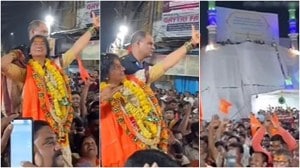- India
- International
Fighting the virus: Many hands behind India’s battle against coronavirus
A surveillance programme set in place in 2004, tested through outbreaks like Nipah, and involving a network spread down to villages, is now at the vanguard against fast-spreading COVID-19.
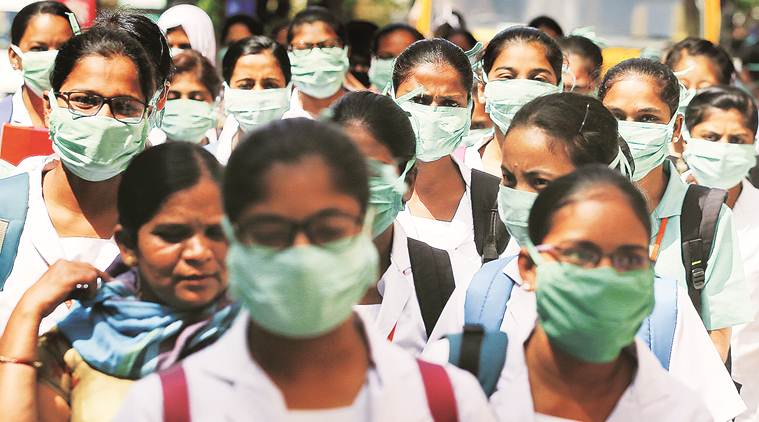 At Gandhi Hospital in Secunderabad. The first case in Telangana was detected on March 2. (AP)
At Gandhi Hospital in Secunderabad. The first case in Telangana was detected on March 2. (AP)
Inside a building in Delhi’s Civil Lines that was once the residence of the last commander-in-chief of the British Army in India, 20 people (doctors or Phds in microbiology/epidemiology) are fielding calls from across the country and abroad. There are two computers to answer emails. When the questions get harder, the National Centre for Disease Control (NCDC) hands over the call to an additional director. A white board at the back has the day’s coronavirus (COVID-2019) situation report issued by the World Health Organisation.
Barely 10 ft by 20 ft, this is the NCDC control room.
In many ways though, it is just the public interface of a complicated, countrywide network of doctors, epidemiologists and field workers that has been developed since 2004 under the Integrated Disease Surveillance Programme (IDSP), and which is now serving as the backbone of the massive manhunt at the core of India’s coronavirus management strategy.
Envisaged for exactly such a situation, the IDSP has in the past been pressed into service against outbreaks such as Nipah in Kerala and tracks in all 33 diseases, including dengue, chikungunya, Japanese encephalitis and typhoid.
Now, across the country, this network is not just getting suspected coronavirus patients to designated hospitals (a total of 106) and laboratories, but also tracking every contact and following them up for 14-28 days to contain the spread of a virus that has affected more than 93,000 people across the world and claimed over 3,000 lives. India has not reported any deaths so far.

Because it is a permanent set-up, a senior NCDC official says, “the systems are robust”.
The IDSP comprises a Central Surveillance Unit, State Surveillance Units at State/UT headquarters level, and District Surveillance Units in all districts, apart from Rapid Response Teams at the ground level.
Opinion | P Chidambaram writes: Economic growth in 2020 may decline further if coronavirus disrupts more production and supply lines
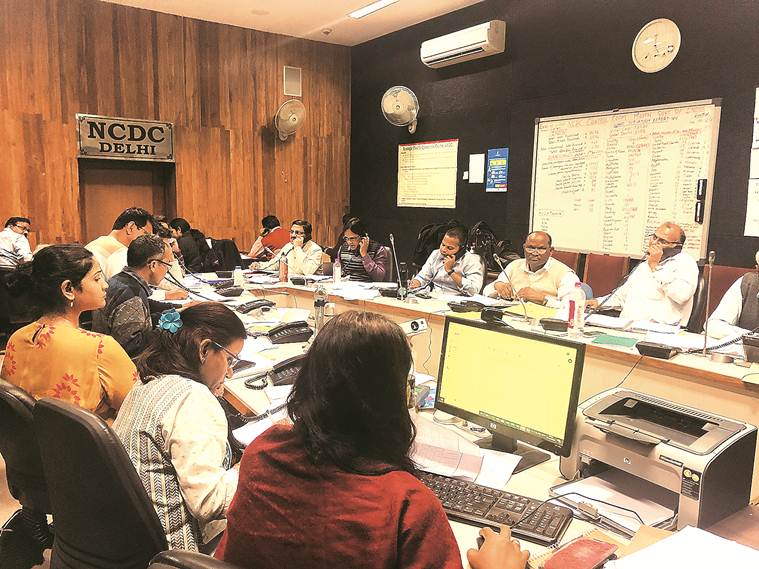 The National Centre for Disease Control received 800-900 calls every day last week regarding COVID-2019. (Express Photo by Abantika Ghosh)
The National Centre for Disease Control received 800-900 calls every day last week regarding COVID-2019. (Express Photo by Abantika Ghosh)
It is no less than a sleuth’s job. Take for example the case of the Kerala student who returned from epicentre Wuhan in China not with the rest of his group but via Bengaluru, using public transport including taxis and trains. “We had information about a group of 40 students who would land at Kolkata airport and then travel to Kochi, and we had prepared the screening and isolation paraphernalia to the last T. However, this student — eventually India’s second case — went to Bengaluru. We tracked down everybody. We did not even have the number of the cab he took. But, based on the time he told us, we asked around and finally traced the driver,” smiles an official.
Asked if lessons from the 2018 Nipah outbreak had been incorporated in the COVID-2019 protocol, an official says, “These are two different diseases with different modes of transmission. There, it was animal-to-human transmission with fruit bats involved. The lessons we have really learnt are from China — to stay prepared and leave nothing to chance.”
The daily drill is less daunting, but as rigorous. Every morning, from 21 airports in the country, the bureau of immigration sends a list of all potential/suspected cases/contacts to the Central Surveillance Unit at the IDSP — shortlisted from thermal screening and self-declaration forms filled out by flyers from abroad. Similar lists come from sea ports and land borders. All, in turn, are circulated to state units, from there to district units and further on to village units. Each state unit has one officer and seven staff members; each district unit a similar set-up.
READ | Coronavirus scare: Primary classes suspended in six J&K dists; two suspected cases
“The staff visits every person listed, counsels them on precaution and isolation. They are given a mask and told that whenever they show any symptom, they should wear it and go straight to the designated hospital and nowhere else. From then on the person is followed up every day for 14-28 days,” says a district surveillance officer from Uttar Pradesh, speaking on condition of anonymity.
If a patient or a suspected contact reaches out to the district unit on his/her own, the central control room in Delhi comes in. The person is given the name and number of their local surveillance officer and informed about the designated hospital.
“We got 800-900 calls every day this week. All the 20 lines are buzzing all day. On Wednesday we got 900 calls during the day, 350 at night. Of them, 100-150 are from abroad, Indians wanting to know when they can come back, foreign tourists trying to find out where all in India it is safe,” says an NCDC official.
Incidentally, even as COVID-2019 hogs headlines, the IDSP has its eyes firmly on swine flu as well. In 2019, over a thousand died of swine flu in the country.
READ | Coronavirus prevention: How to clean your phone
The father: Contacts 105
Around 2 pm on March 2, came the news that the Union Ministry of Health and Family Welfare had been dreading. Twenty-eight days after India had reported coronavirus cases, all in Kerala, the first patient had turned up in Delhi. Unlike the other positive cases who flew down from China, ‘Case No. 4’ was a 45-year-old resident of East Delhi with a travel history to Milan, Budapest and Vienna.
He had left India on a personal trip on February 16 with two brothers-in-law, returning on February 25. The day after, he started complaining of breathlessness coupled with fever, and consulted his family physician who lived in the same locality. The physician suggested he go to RML Hospital, one of the designated hospitals in Delhi for COVID-19, which immediately put him in isolation.
By then, the man had held a birthday party for his school-going son at a five-star hotel in Delhi, while his brothers-in-law had travelled onto Agra. As the news broke, so did panic, triggering the first school shutdown in India related to the virus, as well as quarantines of staff both at the hotel and the airline the three men had taken. Positive cases were also detected in Agra, among the contacts of the brothers-in-law.
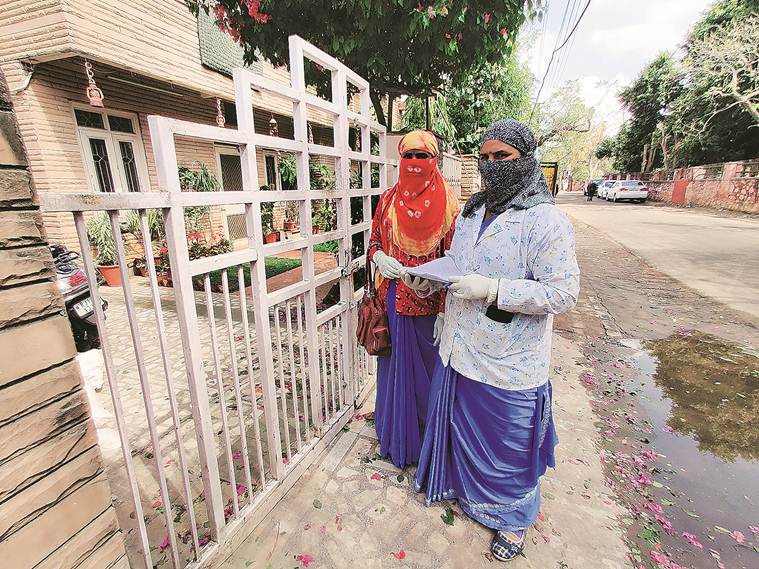 ‘Asha Sahyoginis’ in Jaipur. They have been asked to survey 100 houses a day to look out for high-risk cases. (Express Photo by Hamza Khan)
‘Asha Sahyoginis’ in Jaipur. They have been asked to survey 100 houses a day to look out for high-risk cases. (Express Photo by Hamza Khan)
Says Dr Ahmad Nadeem, district surveillance officer of the East District Health Department of the Delhi government, “As soon as the test results (of Case No. 4) came on March 2, we were informed by a WHO medical officer. We alerted the state nodal officer.”
Even as the patient was shifted to Safdarjung Hospital — the treatment of COVID-19 is only symptomatic — a district task force of 38 officials was formed and started making calls to trace his contact chain. The list included family members (the man’s mother, wife and two children), his five office employees, the physician, five of his son’s classmates whom he had met either at school or at the party, and their parents.
While his family was tested at home, a call was placed to the 45-year-old’s office in East Delhi and the employees told to stay put. A team of NCDC officials arrived at the office to take their samples and the five were sent to Safdarjung Hospital, while their families were told to stay at home.
Calls were to be made over the next five days on an hourly basis to all the families to ensure no one stepped out of homes.
“Among the five employees, two lived in East District, and one each in New Delhi, West Delhi and Uttar Pradesh’s Bulandshahr. Health officers in each district were provided their phone numbers and addresses,” says Dr Nadeem.
A call from the West District team saying the mother of one of the employees was complaining of breathlessness set off another round of panic. “We immediately sent an ambulance and she was admitted to Safdarjung Hospital. She tested negative,” he says.
The contact tracing, of 34 people in all, was done over nine hours, between 3.45 pm and 12.45 am, on March 2. The work spilled over to next day, as the Health Ministry started receiving calls from people who had attended the party at the five-star hotel.
Meanwhile, officials coordinated with the Uttar Pradesh administration and NCDC to trace 71 others who had been in direct and indirect contact with ‘Case No.4’, including his relatives. A team of 179 people from the East District of Delhi, including 40 doctors and 26 pharmacists, were sent out to identify them.

So far, of the contact list of 105 (71 plus 34), most have tested negative (including the five classmates).
Delhi health authorities say they were well-equipped to handle the virus having started active watch of passengers on January 15. As part of the process, field workers made calls as well as visited houses of suspects, armed with a list shared by the Delhi Health Department with all 11 districts in the Capital.
“The calls were first made by officers, and if we were unable to contact the passengers, the field workers went. They were told to ensure a distance of minimum 10 metres from the person concerned. The workers enquired about any persistent fever and cough. If a family agreed, it was told to go to RML Hospital for tests, or suggested home isolation for 14 days,” says Dr Rekha Rawat, Chief District Medical Officer, East District.
The Delhi government now has control rooms in all 11 districts along with a central control room at the office of the Directorate General of Health Services. In all, 25 hospitals have been designated for coronavirus handling.
The Italian tourist: Contacts 215
With the most cases of coronavirus in India traced to Jaipur, the 46-year-old two-storey Infectious Diseases Hospital (IDH), located in a quiet corner of the 50-acre campus of Sawai Man Singh Hospital, has emerged as the headquarters of the fight against the virus. Its 30 beds, including six in ICU, have been set aside for COVID-19 suspects, with doctors on duty 24X7. Currently it holds 11 suspect cases.
Jaipur saw its first patient on March 3, a day after Delhi’s — a 69-year-old Italian tourist, followed by his wife. While the two of them continue to be at the IDH, the 14 other Italians who were part of their tourist group and the driver who ferried them are in Delhi, having moved there by the time they were tested and their results came positive.
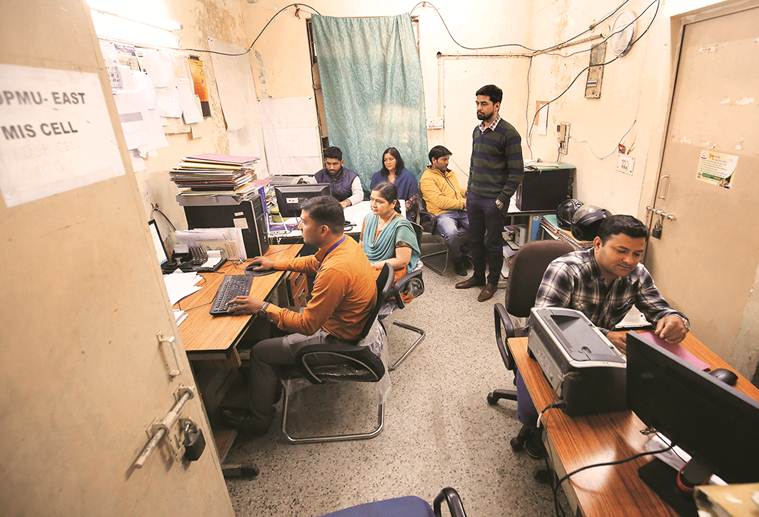 The Delhi East District team handling COVID-2019. (Express Photo by Praveen Khanna)
The Delhi East District team handling COVID-2019. (Express Photo by Praveen Khanna)
On March 4, Rajasthan Health Minister Raghu Sharma informed the Assembly that they were tracking 215 people — including at the Jaipur hotel where the tourists stayed, at the private hospital they first visited, at SMS, apart from others in five other Rajasthan districts they had visited.
Of the 282 samples tested at SMS so far, including from other parts of the state, only the Italian and his wife have been positive. Apart from them, six Indians, and one each from Hong Kong, Japan and Canada, who were not a part of the group of Italian tourists, are in quarantine at the hospital.
IDH in-charge Dr Dilip Raj says the coronavirus facility was set up by them on January 26, when they had their first suspected patient, an MBBS student who had returned from China, who later tested negative. SMS Additional Superintendent Dr Ajit Singh says they already had an isolation facility at the IDH for swine flu.
Then, around January-end, the government of India chose SMS, the largest government hospital in Rajasthan, as one of the centres for coronavirus testing. A month passed off peacefully, till the March 3 positive test and the consequent tracing backwards.
Explained | Sorry, no handshake, it’s the coronavirus. But what do you do, then?
The Italian tourist was found to have flown into New Delhi on February 21, along with 22 others. The same day, the Italian group travelled to Jhunjhunu in Rajasthan on a bus, and subsequently to Bikaner, Jaisalmer, Jodhpur and Udaipur, before arriving in Jaipur on February 28.
That night, complaining of breathlessness, the 69-year-old was taken to hospital from his hotel and kept overnight. With his symptoms suspect, he was referred to SMS and then shifted to the IDH around noon on February 29. While the initial reports for coronavirus and swine flu came out negative, another screening on March 2 tested positive. A second round of testing at the NIV confirmed the virus on March 3.
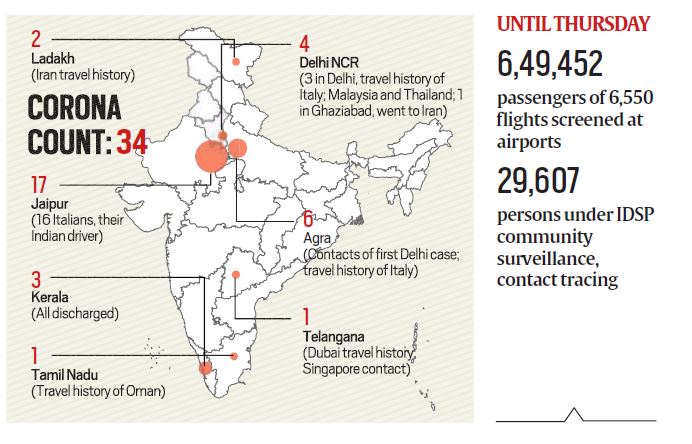
The same day, Rohit Kumar Singh, Additional Chief Secretary, Medical and Health and Family Welfare, directed constitution of Rapid Response Teams at the level of medical colleges across the state. Each team had doctors and epidemiologists and they were told to inspect hotels and tourist sites where the Italian group had stayed or visited. Simultaneously, the districts were asked to ensure that the places are disinfected.
So far, while tests of all their contacts except the 14 have returned negative, new suspects continue to be admitted at the IDH.
SMS Superintendent D S Meena says they are setting up a separate ward within the SMS OPD now for coronavirus. Dr Surjit Singh Rajput, 35, and Dr Lavina, 26, deployed at the Emergency, say that with no way to tell a regular flu patient from one suffering from coronavirus, “We differentiate looking at their travel history.” Dr Lavina says she only started wearing the recommended N-95 mask since last three days.
Among the Health Department’s ‘Asha Sahyoginis’, deployed to conduct surveys, are Pappi Devi, 40, and Kamla Devi, 36, staff at the Urban PHC in Jaipur’s Amagarh Kachi Basti. They say they have been told to look out for high-risk cases — children under 5, elderly over 65 years, pregnant women, and patients with serious ailments.
Pappi says she has been a part of such exercises before, like for Zika virus ahead of Diwali last year. “We have been asked to cover 100 houses daily for seven days.”
Over at the Jaipur international airport, a team of seven doctors and paramedics is screening passengers. Airport Director J S Balhara says there was no significant change in arrivals initially, but in the past week, “they have fallen 25-30%”.
READ | Italy to give Diamond Princess coronavirus quarantine captain its highest honor
The techie: Contacts 88
G Srinivas Rao, Chief Director of Public Health, Telangana, calls his job “a race against time”. Even before the first patient in the state was detected on March 2, Rao had been coordinating the exercise to contain the virus, including setting up an isolation ward at Gandhi Hospital in Secunderabad.
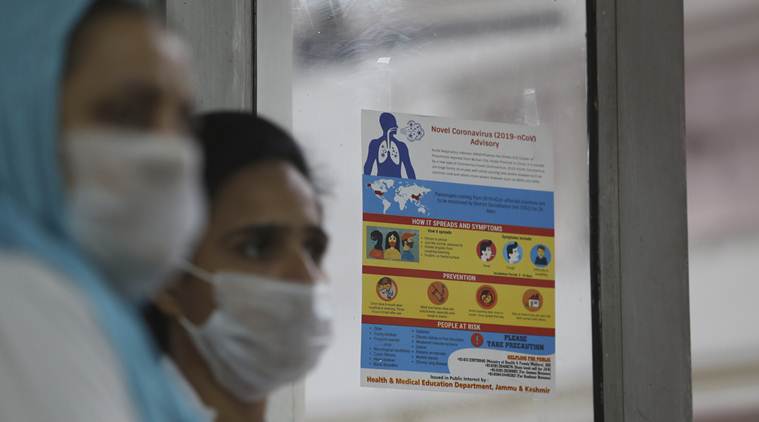 A poster of Coronavirus poster showing symptoms and prevention is pasted at the door of a special ward set aside for possible patients at a government run hospital in Jammu (AP)
A poster of Coronavirus poster showing symptoms and prevention is pasted at the door of a special ward set aside for possible patients at a government run hospital in Jammu (AP)
The state has a core team of 22 pulmonologists plus nurses etc on standby, and has roped in private hospitals, especially those with experience of dealing with swine flu. Around 3,000 beds have been identified in government hospitals for quarantine. There is a helpline in place, as well as a command centre located on the premises of the Directorate of Public Health.
Says Rao, “It is not only those who are infected who are in danger but they can infect others. A worker at Apollo Hospital where the techie who tested positive initially went for treatment, for example, was infected.”
Explained: Amid coronavirus outbreak, how information can be an epidemic too
The 24-year-old software professional returned from Dubai. Once he tested positive, the Health Department carried out a sanitation drive of the Mahindra Hills area where he lives. A quiet, upper middle-class area, Mahindra Hills is home to retired defence forces personnel as well as those working in the nearby IT corridor.
Hundreds of sanitation and health workers spread out over the 3-km radius. Says supervisor Venkateshwarulu, “They were provided masks and suits and went to each house and fumigated and sprayed disinfectants.”
Rao led the narrowing of list of the patient’s contacts to 88 people, who had come in touch with him all the way back to Bengaluru, from where he travelled to Hyderabad by bus. Forty-six of them were fellow bus passengers, and Rao and his team called them up over the next 24 hours.
“I personally spoke to the patient for 45 minutes to get the details. We covered every possible stop and brief contacts. All were asked to report to Gandhi Hospital and have their samples taken,” says Rao.
After two contacts were suspected to be positive, cleaning was taken up of other public places, including Metro stations and trains. The results of their tests, however, turned out to be negative.
At Rajiv Gandhi International Airport in Hyderabad, Regional Director (Health) Dr M Anuradha is leading a group of doctors conducting thermal screening of arrivals.
Coronavirus outbreak: If you have planned a holiday abroad, should you cancel?
The Bengaluru complex: Contacts 717
The Karnataka Health Department had been monitoring travellers from COVID-19 affected countries for 45 days when news came on March 2 of a 24-year-old Hyderabad resident who had tested positive. A data scientist with an artificial intelligence tech start-up based in Bengaluru, he was in Dubai from February 16 to 20, went to office the next day, before heading to Hyderabad on February 22.
Around 5 pm, the state communicable diseases unit under Joint Director Dr B G Prakash Kumar and Bengaluru Urban district disease surveillance officer Dr N Manohar started tracking down all possible Bengaluru links of the patient.
Among the first stops was an apartment complex with 98 flats, located in south east Bengaluru, where the data scientist lived with a computer engineer, as well as his firm at the technology park in Marathahalli region.
 “We were working till late into the night, gathering details of persons to be kept under observation for possible infection,” says Dr Mamatha, an epidemiologist and public health expert with the disease surveillance office.
“We were working till late into the night, gathering details of persons to be kept under observation for possible infection,” says Dr Mamatha, an epidemiologist and public health expert with the disease surveillance office.
The list was narrowed down to 25 people with whom the data scientist had interacted at his office on February 21. Along with Dr Rahat, Dr Mamatha kept tabs on them as well as the patient’s flat mate, who was quarantined, and the inhabitants of their apartment complex. The flat and work place was fumigated, says Dr Manohar.
One 23-year-old co-worker showed symptoms of flu but tested negative, while the roommate remained asymptomatic.
Explained: Putting a cost to coronavirus
Meanwhile, health workers of the state surveillance unit kept tabs on passengers who had flown with the patient from Dubai, the cab driver who had taken him home, and the 23 who had travelled with him on a bus to Hyderabad on February 22.
“Health workers from Primary Health Centres nearest to the location of a person who may have come in contact with the patient were delegated the responsibility,” says Joint Director Kumar.
A health official says they were well-equipped as they have experience of handling epidemics since the recent SARS and swine flu outbreaks. Karnataka has incidentally seen 542 deaths from swine flu over the last decade, including over 150 in the past two years.
Says an epidemiologist with the disease surveillance office, “This time there is a lot of hype, but we are used to the situation. There is nothing to worry about and positive tests are clearly related to people who have travelled to COVID-19 affected countries or come in contact with people from these countries.”
As of now, the state surveillance unit is monitoring health on a regular basis of 300 people with a history of travel to China and other core affected countries.
Case No. 4: Tracing contacts
People deployed to trace the 105 people who came in contact with Delhi’s first patient
March 2, 2 pm
# A 45-year-old East Delhi resident with travel history to Milan, Budapest and Vienna tests positive for COVID-19
# His two brothers-in-law, who travelled with him, also test positive
# East District Health Department informs state nodal officer
# Calls to trace his contact chain begin — family members
(the man’s mother, wife and two children), his five office employees, the family physician whom he had consulted, five of his son’s classmates whom he had met at school or at the birthday party he hosted for his son, and their parents
# Family of Case No. 4 tested at home; calls placed to employees of his office in East Delhi, they are asked to stay put. NCDC officials arrive at the office to take their samples. Calls placed to employees’ families on an hourly basis to ensure no one is stepping out of home
# 34 people traced within 9 hours on March 2-3 between 3.45 pm and 12.45 am
# Health Ministry starts receiving calls from people who had attended the birthday party at the five-star hotel
# Officials coordinate with the Uttar Pradesh administration and NCDC to trace 105 people who had been in direct and indirect contact with Case No. 4
———————
COVID-19 Containment Plan
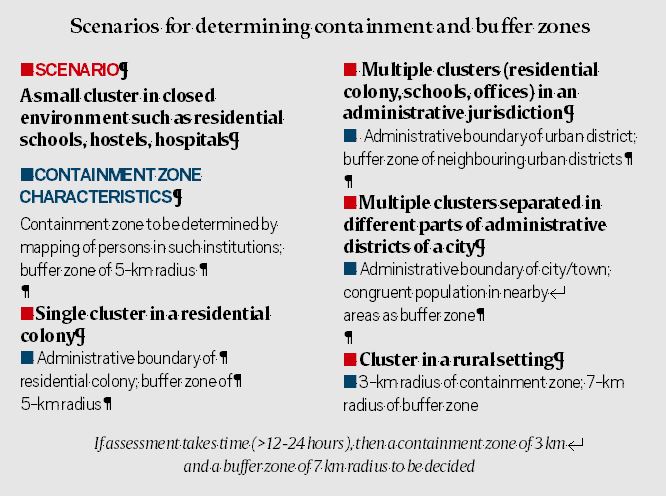
Active surveillance
# The residential areas will be divided into sectors for the ASHAs/Anganwadi workers/ANMs,
each covering 50 households (30 households in difficult areas)
# The field workers will perform active, daily house-to-house surveillance in containment zone (8 am to 2 pm). They will provide a mask to suspect case and caregiver. The patient will be isolated at home till examined by supervisory officer
# All ILI (influenza-like illness) / SARI (Severe acute respiratory infections) reported in last 14 days in containment zone will be tracked and reviewed to identify any missed case of COVID-19 in community
# Supervisory officer will collect data from health workers, collate and provide cumulative data to control room by 4 pm daily
(Source: Ministry of Health & Family Welfare, Government of India)
Apr 18: Latest News
- 01
- 02
- 03
- 04
- 05
















